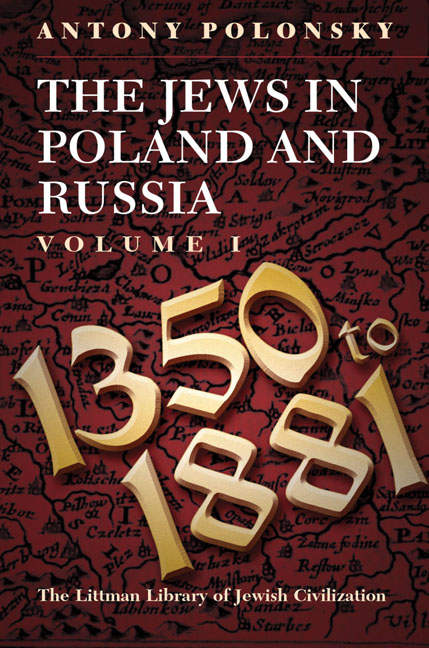Book contents
- Frontmatter
- Dedication
- Acknowledgements
- Contents
- List of Maps
- List of Tables
- Note on Transliteration
- Note on Place Names
- Maps
- General Introduction
- PART I JEWISH LIFE IN POLAND–LITHUANIA TO 1750
- PART II ATTEMPTS TO TRANSFORM AND INTEGRATE THE JEWS, AND THE JEWISH RESPONSE, 1750–1880
- Glossary
- Bibliography
- Index
APPENDIX - The Polish–Lithuanian Background
- Frontmatter
- Dedication
- Acknowledgements
- Contents
- List of Maps
- List of Tables
- Note on Transliteration
- Note on Place Names
- Maps
- General Introduction
- PART I JEWISH LIFE IN POLAND–LITHUANIA TO 1750
- PART II ATTEMPTS TO TRANSFORM AND INTEGRATE THE JEWS, AND THE JEWISH RESPONSE, 1750–1880
- Glossary
- Bibliography
- Index
Summary
The Polish nobility are eager for glory, keen on the spoils of war, contemptuous of danger and death, inconstant in their promises, hard on their subjects and people of the lower orders, careless in speech, used to living beyond their means, faithful to their monarch, devoted to farming and cattle-breeding, courteous to foreigners and guests, and lavish in hospitality, in which they exceed other nations.
JAN DŁUGOSZ, Annales, 1480You should know that Poland is made up of different provinces which are like individual kingdoms. It is so extensive that if you wanted to traverse the space from the extreme limits of Lithuania, which border on Muscovy, to the foothills of the Carpathians, you would need a whole month. And in another direction, calculate how far removed is the mouth of the Dnieper on the Black Sea from the Baltic coast. Therefore I ask: when the representatives of so many peoples, who differ in their past and in their level of prosperity and who are not linked by bonds of family or relationship, is it possible, I ask, when their representatives meet in the Sejm that they can be inspired by a single common idea?
ANDRZEJ M. FREDRO, Przysłowie mów potocznych, 1664The Kingdom of Poland and the Grand Duchy of Lithuania to the Union of Lublin 1569
When Jews found their way to the area at the end of the tenth century, Poland and Lithuania were still separate states. They were linked dynastically in 1385 when Jogaila ( Jagiełło), the grand duke of Lithuania, married Jadwiga, the last ruling Polish monarch descended from the Piast dynasty. She was the daughter of Elisabeth, daughter of King Władysław I Łokietek (r. 1320–33) of Poland, who married Louis, king of Hungary, a member of the Angevin dynasty. Jogaila was crowned king of Poland in 1386, and in 1392 recognized his cousin Vytautas as grand duke of Lithuania, while retaining the title of supremus magnus dux Lithuaniae. The two states were now linked dynastically, and after 1447, when Kazimierz IV Jagiellończyk (Kazimieras I Jogailaitis) finally accepted the Polish throne, they were ruled by a common monarch (except for a hiatus in 1492–1501).
- Type
- Chapter
- Information
- The Jews in Poland and RussiaVolume I: 1350 to 1881, pp. 160 - 180Publisher: Liverpool University PressPrint publication year: 2009

